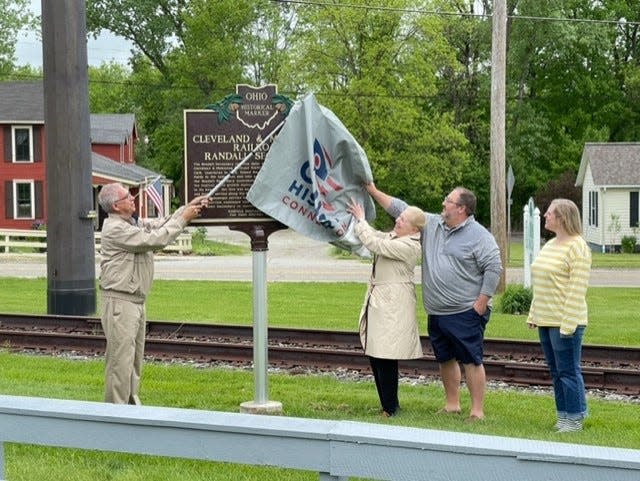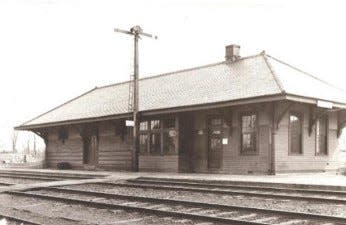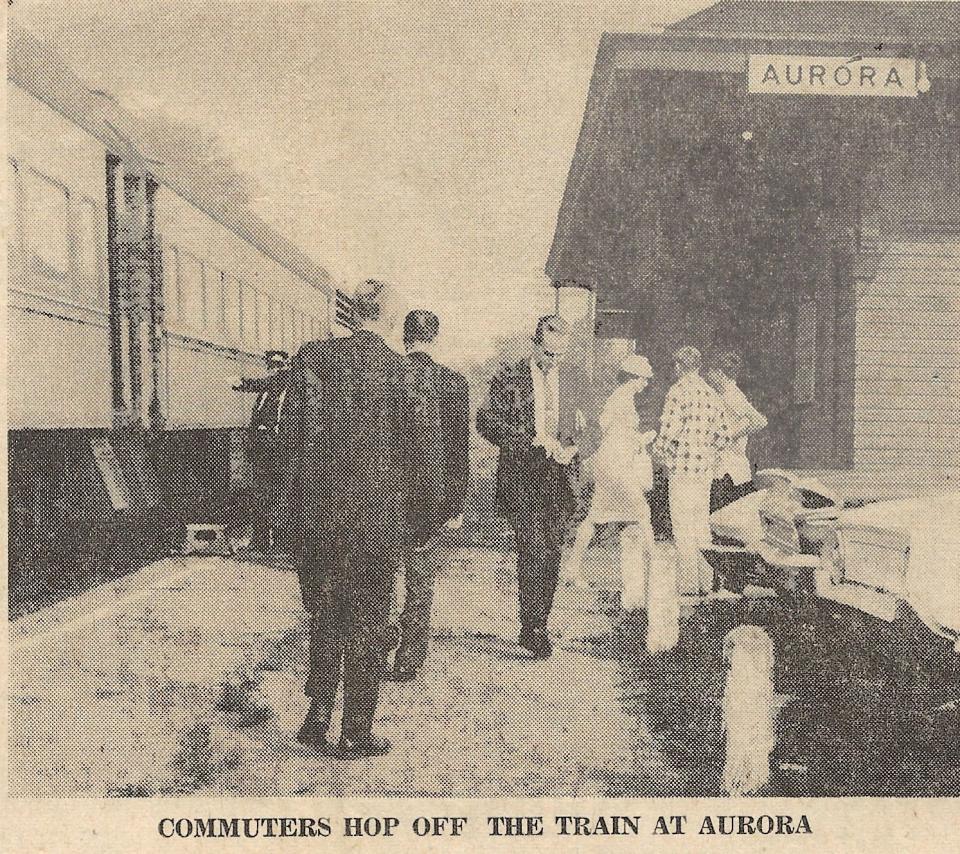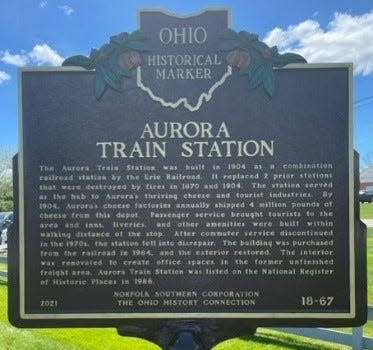Aurora History: Marker commemorates significant role railroad played in city

Running diagonally through Aurora for 5.5 miles was the Cleveland-Mahoning Railroad, which made its last commuter stop at the Aurora Station on East Garfield Road on Jan. 14, 1977. Ten years earlier an article in the Akron Beacon Journal dated Aug. 27, 1967 read “Commuters took the 6:50 a.m. train to Cleveland for a fare of $2.14 and returned to Aurora at 6:05 p.m. The parking lot had about 25 cars. One housewife in a convertible said, ‘we moved to Aurora so my husband could commute by train.’ The Public Utilities Commission gave permission for the station to close by November. After that Aurora would become a ‘whistle stop.’ Commuters could still climb aboard and buy tickets on the train.
Chartered in 1848, the first tracks were laid through Aurora beginning in 1850 with the completion of the line in 1856. As the rail line first entered the northeast part of the city the train stopped at the Erie “Aurora Pond” Station located on the northern edge of what came to be known as Geauga Lake. As the line progressed in a southeastern direction the trains would stop on a daily basis where it intersected with the famous Chillicothe Road (now Ohio Route 306) to pick up shipments of milk headed for the commercial dairies in Cleveland. The historic landmarked “Wee House” purchased by the City of Aurora was a pick up point for milk from local dairy farmers. Continuing on, the line ran to Aurora Station which was the primary commercial center of Aurora. The historic Aurora Station District was the site of grist mills, saw mills, a furniture maker, freight yard, the A.B. Hurd & Sons store and the Frank Treat & Sons store. Focal point of the district was the Aurora Station, which is listed on the National Registry of Historic Places. Adjacent to the line and located along the Chagrin River were numerous cheese factories which are historically recognized through the Ohio Historic Marker Program.

By the latter part of the 20th Century the station played a diminished commercial role for local merchants and with decreasing commuter use the last travelers left the Aurora Station in 1977. After the elimination of the commuter service, the station fell into disrepair. In August, 1982 the station came close to being torn down. The city was notified of the intent to have the station torn down when a private contractor sought a demolition permit. Aurora’s Planning Director Dave Lipstreu stepped in an indicated that the contractor needed to obtain a demolition permit from the Architectural Board of Review. It was at that time that the City’s Landmark Commission and the Aurora Historical Society worked to secure a private party to preserve the station.
The sounds of trains whistling through Aurora have gone silent and the tracks have since been removed. While most of the physical reminders have vanished, significant role that the railroad played in the history of Aurora has been preserved and appropriately commemorated.
The Aurora Historical Society and the City of Aurora’s Landmark Commission have collaborated over the years to bring to the community five historical markers recognizing the significance of historic buildings, landmarks, and individuals. All have been established as part of the Ohio Historical Marker program which is administered by the Local History Services Department of the Ohio History Connection. Since 1957, the program has placed approximately 1,800 markers that share our state's history. Partnering with community sponsors the program tells the unique stories of the people, places, things, or events that helped shape individual communities as well as Ohio and the nation.

Portage County has 19 markers with Aurora having the distinct honor to have six of them. On May 22, 2022 Aurora dedicated its newest marker the “Aurora Train Station.” Sponsored by the Norfolk Southern Railroad two-sided marker relates the early history of the Station along with that of the Cleveland-Mahoning Railroad. The dedication program began with John Kudley,
President of the Aurora Historical Society and vice chairman of the Landmark Commission greeting those in attendance. Mayor Ann Womer Benjamin gave opening remarks on behalf of the city citing the collaboration between the city and the historical society working to preserve the rich history of Aurora. Miranda Fisher from the State of Ohio Historic Preservation Office and representing the “Remarkable Ohio” marker program presented certificates of recognition from the Ohio History Connection and the Secretary of State’s Office.
Among those in attendance was 94 year old Donna Mattmuller, the daughter of Harold E. Miller. Harold was the Aurora Station agent for the Erie Railroad from 1921-1942. He first began working for the railroad at age 15 during the summers under the direction of station agent John McDonald. He was offered a full-time job as clerk at age 16. He took the position and quit high school. He did not graduate from Aurora High School which at that time was a three-year high school. After working in Aurora, Harold became the station agent in Mantua where he remained in that position for another 17 years.
In early July, 2018, the Aurora Historical Society was contacted by the Surface Transportation Board in Washington D.C. asking if we wanted to be “an interested party” in Norfolk Southern’s request to abandon the railroad line. It was at that time that the society, along with the city became deeply involved in the abandonment process. The Society participated in a virtual meeting at which time it expressed the need that if the abandonment went through we would request that two things be part of the agreement.

First, it was agreed that an Ohio Historical Marker application be made to the Ohio Remarkable program by Norfolk Southern in collaboration with the Aurora Historical Society. As a result, the railroad sponsored the marker with Norfolk Southern and the Aurora Historical Society having the responsibility for the wording on each side of the marker. The manufacturing of the marker and its installation was paid for by the railroad. Second, it was negotiated that the track rails be preserved from Route 82 to the end of the Aurora Station Property owned by Demming Financial Services.
In addition to the concession made by Norfolk Southern and after the city’s lengthy legal dispute over the acquisition of the railroad line by First Energy Corp. it was agreed that First Energy would “clean up” the Train Station Historic District by eliminating and consolidating many of the poles in the District. Through the efforts of Mayor, City Council and the city’s Law Department an easement along the entire railroad line was also part of the agreement with First Energy. That portion of the settlement is in progress as the company deals with other utilities that occupy the poles.
The text on the marker reads, “The Aurora Train Station was built in 1904 as a combination railroad station by the Erie Railroad. It replaced 2 prior stations that were destroyed by fires in 1870 and 1904. The station served as the hub to Aurora’s thriving cheese and tourist industries. By 1904, Aurora’s cheese factories annually shipped 4 million pounds of cheese from this depot. Passenger service brought tourists to the area and inns, liveries, and other amenities were built within walking distance of the stop. After commuter service discontinued in the 1970s, the station fell into disrepair. The building was purchased from the railroad in 1984, and the exterior restored. The interior was renovated to create office spaces in the former unfinished freight area. Aurora Train Station was listed on the National Register of Historic Places in 1986.”
The text on the reverse side of the marker reads, “The Randall Secondary rail line dates to the 1850s when the independent Cleveland & Mahoning Railroad (C&M) laid tracks through Aurora, Ohio. C&M, chartered in 1848, linked the Mahoning Valley coal and iron ore fields to the industries and lake port at Cleveland. For over a century, the Randall Secondary contributed to
Aurora’s economic life — fueling the region’s rapid growth during the late 19th and early 20th centuries. In its heyday, the line was an important route for commuter transport and freight service along the 67 miles between Cleveland and Youngstown. Although passenger service into Aurora Train Station stopped in the 1960s, freight service continued into the 1990s. The last remaining track of the Randall Secondary in Aurora stands near the station it served.”
The marker is located at 13 New Hudson Road on the Norfolk Southern easement along the railroad track adjacent to the Train Station now the offices of Demming Financial Services. Placement of the marker and preservation of the track were concession required by the historical society and the city for abandonment of the railroad line by Norfolk Southern.
Author’s Note: The mission of the Aurora Historical Society is to preserve Aurora’s history and to impart that history to the Aurora community. When the pandemic began the society had to close its doors to the public. To fulfill our mission during that time we have published sixty articles in the Aurora Advocate recounting the history of Aurora.
Printed with the permission of the Aurora Historical Society which retains rights to all content and photos.
This article originally appeared on Record-Courier: Aurora History: Marker commemorates significant role of railroad

